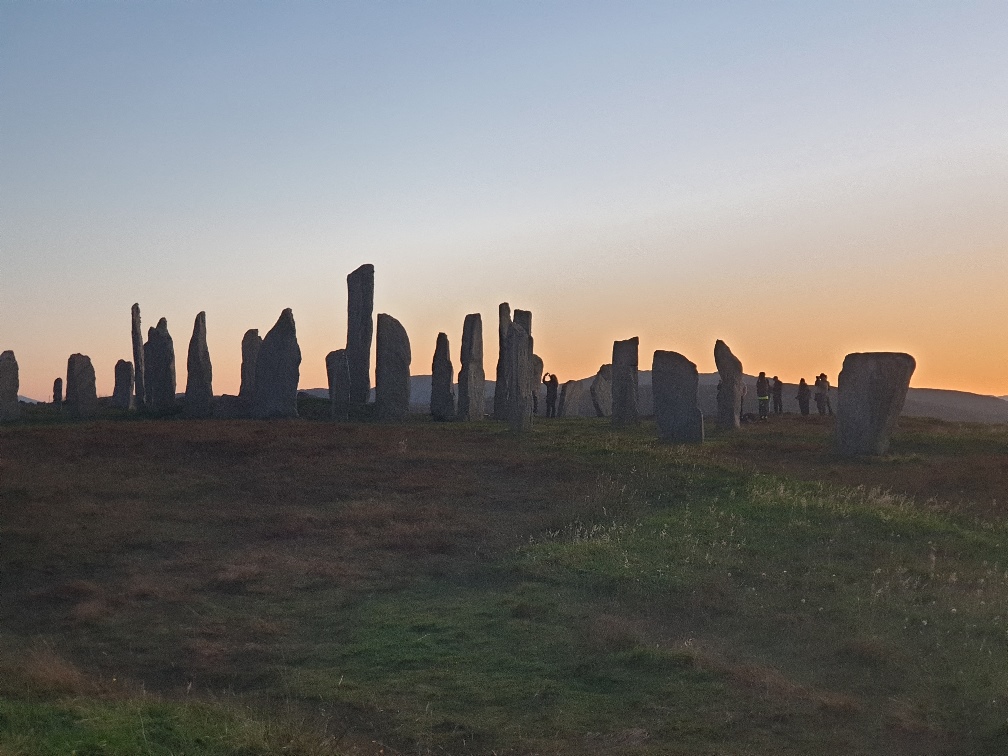
The Callanish stone circle can be found on the Isle of Lewis off the north west coast of Scotland. Erected in the late Stone Age (over 5000 years ago) the stones are arranged in a cross formation with a central stone circle consisting of 13 stones, and 13 metres in diameter. A long avenue runs north-southwards with three additional stone rows radiating outwards towards the other three cardinal points.
This prehistoric monument seems to have been designed as an observatory or perpetual calendar. The first clue is the number 13 (there are 13 lunar months in a year). The second clue is the exact north-south facing direction of the huge central stone, marking the cardinal directions. No mean feat in the days before compasses.
The stones are located on a ridge with 360 degree views of the horizon in a spectacular natural landscape of lochs (lakes) and mountains. Against this backdrop, the Callanish stones weave sky and land together, reflecting the complex movements of sun and moon.
Remarkably, Callanish references the moon's major standstill every 18.6 years when the full moon appears at its most northerly position on the horizon, skimming the distant mountain range and shining through the stones. (The next major lunar standstill will be in April 2025, the last one was in January 2006, so if you get the chance to travel to Scotland this year, and the weather's looking good, consider a side trip to the Outer Hebrides!)

Aerial image credit: Gail Higginbottom & Roger Clay / RCAHMS.
DIODORUS AND HIS GAP YEAR
Two thousand years ago, a classical historian, Diodorus of Sicily, travelled to a place he called Hyperborea, which seems to refer to Celtic Britain. Here's what Diodorus had to say about the Isle of Lewis and Callanish.
"There is an island, as big as Sicily, under the Arctic Pole, where the Hyperboreans inhabit... They have a temple of round form, beautiful with many rich gifts... They say the moon in this island seems as if it were near to the earth, and that Apollo once in nineteen years comes to the island... in which time the stars perform their courses and return to the same point."
WHY IS THE LUNAR STANDSTILL SO IMPORTANT?
It is easy to understand why full moons and solstices were important to the circle builders. Each full moon had its own special significance and probably its own special stone. The summer solstice would hail a time of long daylight hours, abundant food and mild weather. The winter solstice would mark the turning point of the long dark winter. But why was the lunar standstill such a big deal? Was it something to do with the celebration or regeneration of Mother Earth?
Clearly these longer cycles of time were very important to the circle builders. I don't believe they were just Stone Age farmers. Their astronomy is far too sophisticated.

Lunar Standstill diagram: Griffith Observatory
A FOREIGN LEGACY?
You may be aware of the excavations taking place at Göbekli Tepe and surrounding areas in Turkey. Excavations revealing incredible carved stone pillars dating back to 9000 BC. Stone carvings that reference the sun, moon and stars. Monuments built 6000 years before Callanish. Our whole view of history is being challenged by these discoveries, as we have no idea who built Göbekli Tepe. My belief is that the sophisticated stone circle technology of Europe is a legacy from these earlier times. A technology designed to connect us to the cosmos and heal the earth.
I leave you with this fascinating legend about the builders of Callanish, courtesy of Ian McHardy. The mystery continues...
"Once upon a time, there was a great King who was also a Holy Priest. He came to Lewis with many ships and in the ships were lesser priests and great stones and black men to handle them. It was these black men who set up the Circle. When the stones were all in place, some of the priests and the black men sailed away, but the Great Priest stayed and with him lesser priests and he invited men from other Isles to come and serve him and some came. The priests wore robes made of the skins and feathers of birds, that of the Chief Priest being white with a girdle made from the neck feathers of mallard drakes; the other priests wore feather cloaks of mixed colours. The Chief Priest never appeared without wrens, or a wren flying near him."


Lunar Eclipse at Callanish - 18th September 2024 (Image: Stella Woods)
